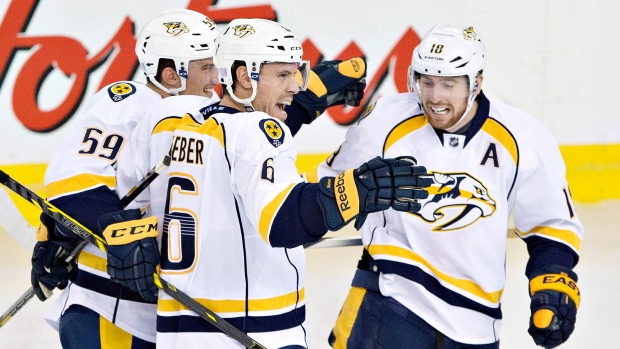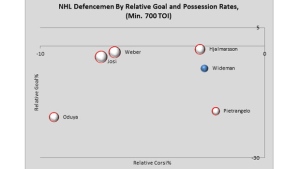Jan 8, 2015
Is Shea Weber being overworked in Nashville?
One of the most interesting questions that the hockey analytics community has dealt with in recent years has concerned the old Ryan Suter and Shea Weber defence pairing in Nashville. Travis Yost takes a closer look, particularly at Weber, this season.
By Travis Yost

One of the most interesting questions that the hockey analytics community has dealt with in recent years has concerned the old Ryan Suter and Shea Weber defence pairing in Nashville. When that pairing existed, both players were individually recognized as elite defenders, with Shea Weber being received as the slightly better of the two. The pairing eventually broke up in the summer of 2012, when Ryan Suter left Nashville for a $98-million contract in Minnesota.
Though both are still great players, I think it’s fair to say that the reputation of each has taken a slight hit since the break. Part of this is tied into the fact that their underlying numbers have never been as impressive as some of the other game-changing defenders around the league at even-strength, who generally post quality on-ice Goal% rates and on-ice Corsi% year after year. This, of course, is because most every team is usually moderately to significantly better with their first pairing on the ice, with performance depreciating as lesser pairings and players replace them.
Suter was the first to go through this. Last year, talk about Suter’s performance wasn’t critical, but appropriately focused on whether or not the team was simply playing their top-defenceman too many minutes. At the time, I think those concerns were at the very least fair – the Wild were a better possession team with him off of the ice than on, and he was playing basically half of every game. Despite improving on those underlying numbers this year, those concerns have not subsided.
What’s interesting is that Suter isn’t the only player who has looked a bit unimpressive by first-pairing standards since the split. For the third straight year, Weber is posting negative possession numbers relative to his team – that is to say, with Weber off of the ice, Nashville’s in better territorial control of things. And, this season, Nashville’s actually getting a better portion of the goal-scoring with Weber off of the ice.
I think this gets into a larger question about first-pairing and heavily-used second-pairing defenders who may be playing too many minutes, and how we can go about identifying them. What I’ve decided is to pull the twenty-two defencemen who have already logged at least 700-minutes at 5-on-5, then eliminate any defender who (a) is posting positive possession rates relative to the rest of his teammates; and/or (b) is posting positive goal rates relative to the rest of his teammates. As you would expect, this criteria cuts the 22-defenders (including Subban, Giordano, Karlsson, Doughty, et al.) down considerably.
Who are we left with? I’ve graphed out the remaining heavily-used defencemen by relative possession rates, relative goal rates, and relative zone start rates below. Bubble color will indicate zone starts – players with blue bubbles see softer deployment, and players with white bubbles see tougher deployment. The size of the bubble indicates how big of a disparity the player’s zone starts are from the team average.

The first thing you will notice – no Ryan Suter! Despite the unparalleled ice-time, he’s actually putting together a respectable season. Furthered development of Jonas Brodin – his frequent defence partner – may be helping.
I think there are two other bubbles that stand out here pretty considerably, and those are Dennis Wideman and Johnny Oduya. Wideman, because he’s the only defenceman posting negative possession and goal rates despite seeing favorable zone start deployment and Oduya because he is just getting absolutely crushed this season, and the disparity in Chicago’s numbers with him on the ice versus with him off of the ice is jarring. What’s interesting here is that both are regarded as second-pairing defencemen. Oduya (and by extension Niklas Hjalmarsson) actually plays more than the venerable Duncan Keith and Brent Seabrook pairing at 5-on-5, though the margin is somewhat small.
The same is true with Wideman (and by extension Kris Russell), who generally play as much as, if not a sliver more than the great Giordano/Brodie duo at 5-on-5. Now, there’s no doubt that their big step-up in minutes at 5-on-5 has created opportunity for other, more skilled defenders to get more power-play time. But, is the trade-off worth it? It’s a legitimate question, based on the above.
There is, also, Shea Weber – the player we talked about earlier. He’s become the player in the middle of the analytics debate, where the ‘eye test’ suggests he’s one of the best in the business, and the numbers suggest that’s probably not accurate. His frequent partner, Roman Josi, sits right next to him on the graph.
It’s clear to me that Weber and Josi are being used in a shot and goal deterrence role after a quick glance at their deployment – aside from the zone starts, they currently rank #1 and #2 in quality of competition faced, another item worth recognizing. Jump through that hyperlink, though, and you’ll notice that Weber’s deployment is identical to that of Marc-Edouard Vlasic and Mark Giordano. Both of those players thrive in similarly difficult minutes.
It’s certainly one of those topics where I think more in-depth examination is warranted, especially as it pertains to Weber – the player that we thought was carrying Ryan Suter around for all of those years in Nashville. The numbers say he’s doing a decent job in very challenging 5-on-5 minutes, but they also say he’s underperforming a bit relative to other Norris Trophy hopefuls, and maybe has been for some length of time.
Nashville is likely satisfied with having a player of Shea Weber’s abilities on your roster. He’s playing the toughest minutes on the team, and one could easily take the side that his getting beat-up a bit with some harsh deployment is of the benefit to the Predators as a whole. Would the likes of Ryan Ellis (56.1% Corsi%), Mattias Ekholm (55.2% Corsi%), Seth Jones (55.4% Corsi%), and so forth be as successful territorially this year without the Weber/Josi shutdown pairing eating up some of the tough minutes? I think the reasonable answer to that is no.
But, on the other hand, Weber’s not in a position unseen around the league – we talked about Vlasic and Giodano being deployed in almost identical spots, for example. Why does this particular group in Nashville seem to struggle relative to other great players and pairings around the league?
If I’m David Poile, and I’m paying this particular player $7.8-million through the 2026 season, it’s an issue I’m investigating further.



